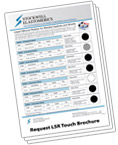Contact Stockwell Elastomerics
Request a quote or get more information.
The following is a list of technical tips on mold design and materials for LIM with LSR.
The improved tear resistance and mechanical properties of liquid silicone rubber make it the material of choice for complex elastomeric components such as grommets with undercuts and components that would perform better without draft angles. Since silicones are fully cured and pliable after the press cure cycle, LSR molded components can be de-molded from cavities with undercuts and no draft angles without distortion.
The de-molding methods of complex LSR molded shapes, enhanced by the pliability of the full cured liquid silicone, eliminate the need for ejector pins and other features typically observed in plastic injection molding. Uncured liquid silicone is a low viscosity polymer that, under pressure, will flow into any void greater than .0005″. This property would counteract any benefit of ejector pins and slides in the tooling as they would quickly become clogged.
Gating of liquid injection molded components is typically designed at the parting line – where the plates open. This often allows for 2 plate molds that are of relatively simple construction, further reducing tooling cost and lead time.
The machining finish for molding liquid silicone components in the cavities is typically a 32 to 64 microinch finish. No spray or mold release is used between heats – liquid silicone releases well from properly machined steel molds. Special textured finishes can be applied to cavities where texturing enhances the properties of the molded component. Samples of molded liquid silicone components with textured surface finishes are available for examination.
Liquid silicone rubber compounds are formulated to have consistent shrink properties. Therefore, the tool designer can calculate a shrink factor that will yield consistent results from batch to batch. Further, since liquid silicone injection molding occurs in a closed mold, the “closure” or thickness dimensions of the molded gaskets will be held tighter than can be achieved by compression molding using a traditional gum base silicone compound. Refer to the Rubber Molding Industry Standard A2 Precision tolerance table (below) when designing components to be molded from liquid silicone rubber. Parting line flash can be removed with a cryogenic de-flashing system or a simple tear trim when the design allows this.
“A2” Precision Drawing Designation
Dimensional Tolerance Table for Molded Rubber Products
| Size (Millimeters) | Size (Inches) | ||||
|---|---|---|---|---|---|
| Above – Included | Fixed | Closure | Above – Included | Fixed | Closure |
| 0 – 10 | ±.16 | ±.20 | 0 – .40 | ±.006 | ±.008 |
| 10 – 16 | .20 | .25 | .40 – .63 | .008 | .010 |
| 16 – 25 | .25 | .32 | .63 – 1.00 | .010 | .013 |
| 25 – 40 | .32 | .40 | 1.00 – 1.60 | .013 | .016 |
| 40 – 63 | .40 | .50 | 1.60 – 2.50 | .016 | .020 |
| 63 – 100 | .50 | .63 | 2.50 – 4.00 | .020 | .025 |
| 100 – 160 | .63 | .80 | 4.00 – 6.30 | .025 | .032 |
| 160 & over | X .004 | x .005 | 6.30 & over | X .004 | X .005 |
For more information on dimensional tolerancing, view this technical tips page: Dimensional Tolerances for Rubber Molded Components.
Most applications are supplied in Black, Light Gray or White. The liquid silicone is provided unpigmented in industrial sized kits of Part A and Part B. The pigment is added during the mixing process prior to injection into the mold cavity. Along with clear (unpigmented), there are approximately 20 colors available to the designer from in-house inventory of pigments, ranging from blue, yellow, green and red. Components molded from colors are more costly in low volume production due to the changeover process required for color changes. If a special color is needed to match a requirement, a Pantone number should be provided and Stockwell Elastomerics’ pigment specialist will match it. Due to the need for special hoses, color pots and color matching, a special color will require approximately $1900 for a non-recurring set up. To see what is already available from standard pigments existing inventory. color swatches can be sent for examination.
Stockwell Elastomerics makes 12″ x 12″ sheets .020″ through .250″ thick, with custom non-standard thicknesses also available. The same compounds used to make custom geometries are used to make sheets in 10 to 70 durometer (Shore A). This special capability combined with four in-house water jet cutters allows Stockwell Elastomerics to provide custom liquid silicone rubber parts exceptionally fast to support requirements for limited production and prototypes where timing is critical. This capability takes sheet molding to water jet cut gasket in-hand in days instead of weeks.
 Request a Free Liquid Silicone Rubber Touch Brochure
Request a Free Liquid Silicone Rubber Touch BrochureIncludes small samples of cured LSR materials to touch and feel.
Contact Us for further assistance with mold design assistance for liquid injection molding (LIM) using liquid silicone rubber (LSR) materials.